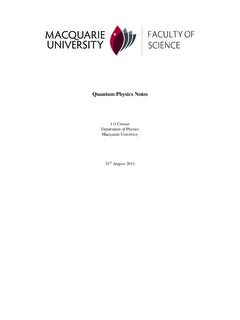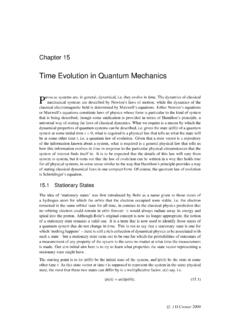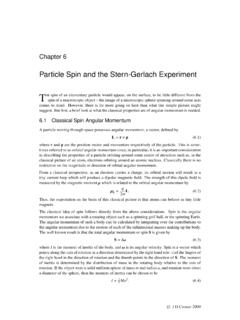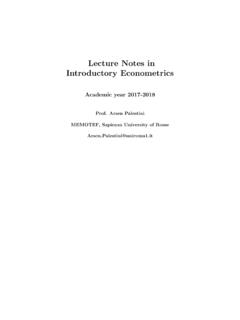Transcription of Lecture Notes on Special Relativity - Macquarie University
1 Lecture Notes on Special Relativityprepared byJ D CresserDepartment of PhysicsMacquarie University8thAugust 2005 Contents1 Introduction: What is Relativity ?32 Frames of an Arbitrary Reference Frame .. Frames of Reference .. s First Law of Motion ..133 Newtonian Galilean Transformation .. Force and Momentum .. s Second Law of Motion .. s Third Law of Motion .. Relativity .. s Equations and the Ether ..194 Einsteinian s Postulates .. Synchronization in an Inertial Frame .. Transformation .. Kinematics .. Contraction .. Dilation .. of Velocities (Addition of Velocities).
2 Dynamics .. Momentum .. Force, Work, Kinetic Energy .. Relativistic Energy .. of Mass and Energy .. Rest Mass Particles ..44 CONTENTS25 Geometry of Flat Properties of 3 Dimensional Space .. Time Four-Vectors .. Space .. of Spacetime Intervals .. Notation .. Einstein Summation Convention .. Vectors and Contravariant Components .. Metric Tensor .. and Covariant Components .. of Differential Operators .. Examples .. Properties of Tensors ..636 Electrodynamics in Special Faraday Tensor .. of the Electromagnetic Field ..67 Chapter 1 Introduction: What is Relativity ?U the end of the 19th century it was believed that Newton s three Laws of Motion andthe associated ideas about the properties of space and time provided a basis on which themotion of matter could be completely understood.
3 However, the formulation by Maxwell of aunified theory of electromagnetism disrupted this comfortable state of affairs the theory wasextraordinarily successful, yet at a fundamental level it seemed to be inconsistent with certainaspects of the Newtonian ideas of space and time. Ultimately, a radical modification of these latterconcepts, and consequently of Newton s equations themselves, was found to be necessary. It wasAlbert Einstein who, by combining the experimental results and physical arguments of others withhis own unique insights, first formulated the new principles in terms of which space, time, matterand energy were to be understood.
4 These principles, and their consequences constitute the SpecialTheory of Relativity . Later, Einstein was able to further develop this theory, leading to what isknown as the General Theory of Relativity . Amongst other things, this latter theory is essentiallya theory of (both the Special and General theories), quantum mechanics, and thermodynamics arethe three major theories on which modern physics is based. What is unique about these threetheories, as distinct from say the theory of electromagnetism, is their generality. Embodied in thesetheories are general principles which all more specialized or more specific theories are requiredto satisfy.
5 Consequently these theories lead to general conclusions which apply to all physicalsystems, and hence are of enormous power, as well as of fundamental significance. The role ofrelativity appears to be that of specifying the properties of space and time, the arena in which allphysical processes take is perhaps a little unfortunate that the word Relativity immediately conjures up thoughts aboutthe work of Einstein. The idea that a principle of Relativity applies to the properties of the physicalworld is very old: it certainly predates Newton and seems to have been first stated concisely byGalileo, though some of the ideas were already around at the time of Aristotle (who apparentlydid not believe in the principle).
6 What the principle of Relativity essentially states is the following:The laws of physics take the same mathematical form in all frames of reference movingwith constant velocity with respect to one recognized in this statement is the empirical fact that the laws of nature, almost withoutexception, can be expressed in the form of mathematical equations. Why this should be so is aprofound issue that is not fully understood, but it is nevertheless the case that doing so offers themost succinct way of summarizing the observed behaviour of a physical system under reproducibleexperimental conditions. What the above statement is then saying can be ascertained as 1 Introduction: What is Relativity ?
7 4 Consider a collection of experimenters, (or, as they are often referred to, observers) each basedin laboratories moving at constant velocities with respect to one another, and each undertaking aseries of experiments designed to lead to a mathematical statement of a particular physical law,such as the response of a body to the application of a force. According to the principle of Relativity ,the final form of the equations derived (in this case, Newton s laws) will be found to have exactlythe same form for all should be understood that whilst the mathematical form of the laws will be the same, the actuallydata obtained by each experimenter even if they are monitoring the same physical event willnot necessarily be numerically the same.
8 For instance, the point in space where two bodies collide,and the time at which this collision occurs, will not necessarily be assigned the same coordinatesby all experimenters. However, there is invariably a mathematical relationship between such dataobtained by the different observers. In the case of Newtonian Relativity these transformation equa-tions constitute the so-called Galilean transformation. Using these transformation equations, themathematical statement of any physical law according to one observer can be translated into thelaw as written down by another observer. The principle of Relativity then requires that the trans-formed equations have exactly the same form in all frames of reference moving with constantvelocity with respect to one another, in other words that the physical laws are the same in all suchframes of statement contains concepts such as mathematical form and frame of reference and Galileantransformation which we have not developed, so perhaps it is best at this stage to illustrate its con-tent by a couple of examples.
9 In doing so it is best to make use of an equivalent statement of theprinciple, that is:Given two observers A and B moving at a constant velocity with respect to one an-other, it is not possible by any experiment whatsoever to determine which of the ob-servers is at rest or which is in motion .First consider an example from everyday experience a train carriage moving smoothly at aconstant speed on a straight and level track this is a frame of reference , an idea that will bebetter defined later. Suppose that in a carriage of this train there is a pool table and suppose youwere a passenger on this carriage, and you decided to play a game of pool.
10 One of the first thingsthat you would notice is that in playing any shot, you would have to make no allowance whatsoeverfor the motion of the train. Any judgement of how to play a shot as learned by playing the gameat home, or in the local pool hall, would apply equally well on the train, irrespective of how fastthe train was moving. If we consider that what is taking place here is the innate application ofNewton s Laws to describe the motion and collision of the pool balls, we see that no adjustmenthas to be made to these laws when playing the game on the moving argument can be turned around. Suppose the train windows are covered, and the carriageis well insulated so that there is no vibration or noise there is no immediate evidence tothe senses as to whether or not the train is in motion.













